Sandgrouse
| Sandgrouse | |
|---|---|
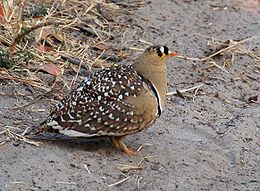
| |
| Double-banded sandgrouse | |
| Scientific classification | |
| Domain: | Eukaryota |
| Kingdom: | Animalia |
| Phylum: | Chordata |
| Class: | Aves |
| Clade: | Columbimorphae |
| Order: | Pterocliformes Huxley,1868 |
| Family: | Pteroclidae Bonaparte,1831 |
| Genera | |
| |
| Synonyms | |
| |
Sandgrouseis the common name forPteroclidae/tɛˈrɒklɪdiː/,afamilyof sixteen species ofbird,members of the orderPterocliformes/ˌtɛrəklɪfɔːrmiːz/.They are traditionally placed in twogenera.The two central Asian species are classified asSyrrhaptesand the other fourteen species, from Africa and Asia, are placed in the genusPterocles.They are ground-dwelling birds restricted to treeless, open country, such as plains, savannahs, and semi-deserts. They are distributed across northern, southern, and eastern Africa, Madagascar, the Middle East, and India through central Asia. The ranges of theblack-bellied sandgrouseand the pin-tailed sandgrouse even extend into the Iberian Peninsula and France, andPallas's sandgrouseoccasionallybreaks outin large numbers from its normal range in Asia.
Description
[edit]Sandgrouse have small, pigeon-like heads and necks and sturdy compact bodies. They range in size from 24 to 40 centimetres (9.4 to 15.7 in) in length and from 150 to 500 grams (5.3 to 17.6 oz) in weight. The adults aresexually dimorphicwith the males being slightly larger and more brightly colored than the females. They have eleven strong primary feathers and long pointed wings, giving them a fast and direct flight. The muscles of the wings are powerful and the birds are capable of rapidtake offand sustained flight. In some species, the central feathers in the tail are extended into long points.
The legs are short and members of the genusSyrrhapteshave feathers growing on both the legs and toes, and no hind toes, while members of the genusPterocleshave legs feathered just at the front, no feathers on the toes, and rudimentary hind toes raised off the ground.[1]
Theplumageiscryptic,generally being in shades of sandy brown, grey and buff, and variously mottled and barred, enabling the birds to merge into the dusty landscape. There is a dense layer of underdownwhich helps insulate the bird from extremes of heat and cold. The feathers of the belly are specially adapted for absorbing water and retaining it, allowing adults, particularly males, to carry water to chicks that may be many miles away from watering holes.[2][3]The amount of water that can be carried in this way is 15 to 20 millilitres (0.5 to 0.7 fluid ounces).[4]
Distribution
[edit]
Members of the genusSyrrhaptesare found in thesteppesof central Asia. Their range extends from theCaspian Seathrough southernSiberia,Tibet,andMongoliato northern and centralChina.They are normally resident, butPallas's sandgrousecan be locallymigratoryand very occasionally is irruptive, appearing in areas well outside its normal range. This happened in 1863 and 1888, and a major irruption took place in 1908 when many birds were seen as far afield as Ireland and the United Kingdom where they bred inYorkshireandMoray.[3][4]
Members of the genusPteroclesare mainly found in the drier parts of northern, eastern, and southernAfrica,though the range of some species extends into theMiddle Eastand westernAsia.The Madagascar sandgrouse is restricted toMadagascar.Theblack-bellied sandgrouseand thepin-tailed sandgrousealso occur inSpain,Portugal,and southernFrance.Most species aresedentarythough some make local migrations, typically to lower altitudes in winter.[4]
Behaviour and ecology
[edit]Diet and feeding
[edit]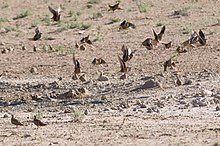
Sandgrouse are principallyseed eaters.Other food items eaten include green shoots and leaves,bulbs,andberries.Insect food such asantsandtermitesmay also be eaten, especially during the breeding season.[1]The diet of many sandgrouse is highly specialised, with the seeds of a small number of plant species being dominant. This may depend on local availability but in other cases it reflects actual selection of favoured seeds over others by the sandgrouse. Seeds ofleguminousplants are usually an important part of the diet. Inagriculturalareasoatsand other grain are readily taken. Seeds are either collected from the ground or directly from the plants.
Foragingtechniques vary between species that coexist, which reduces competition; in Namibia,double-banded sandgrousefeed slowly and methodically whilstNamaqua sandgrousefeed rapidly, exploring loose soil with their beaks and flicking it away sideways.[5]Grit is also swallowed to help grind up food in thegizzard.[1]
Sandgrouse are gregarious, feeding in flocks of up to 100 birds. As a consequence of their dry diet, they need to visit water sources regularly. Drinking times vary among the species. Ten species drink at dawn, four at dusk, and two at indeterminate times.[1]When drinking, water is sucked into the beak, which is then raised to let the water flow down into the crop. By repeating this procedure rapidly, enough water to last twenty four hours can be swallowed in a few seconds.[1]As they travel to water holes, theycallto members of their own species and many hundreds or thousands synchronise their arrival at the drinking site despite converging from many different locations scattered over hundreds of square miles (kilometres) of territory.[6]
They are vulnerable to attack while watering but with a large number of birds milling about, predators find it difficult to select a target bird and are likely to have been spotted before they can get close to the flock.[3]The choice of a watering site is influenced by the topography of the nearby ground. The sandgrouse tend to avoid sites with cover for mammalian predators and their greatest risk is usually from predatory birds.[7]
Sandgrouse travel tens of miles to their traditional water holes and tend to disregard temporary water sources which may appear periodically. This clearly has a survival value, because a dried up water source in an arid region could result in dehydration and death.[3]The Burchell's sandgrouse in theKalahari Desertsometimes travels over 100 miles (160 km) daily to reach a water source.[4]Not all species need to drink every day, and theTibetan sandgrousedoes not need to travel to drink, because of the abundance of water from melting snowfields in its habitat.[3]
Breeding
[edit]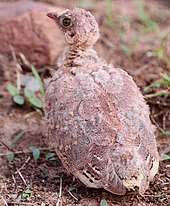
Sandgrouse aremonogamous.The breeding season usually coincides with a crop of seeds after the local rainy season and at this time the feeding flocks tend to break up into pairs. The nesting site is a slight depression in the ground, sometimes lined with a few pieces of dry foliage. Most typically, three cryptic eggs are laid, though occasionally there may be two or four. The intricately patterned, precocial downy young, and egg colouration (though not shape) closely resemble those of manyCharadriiformes.Eggs are near elliptical.[8]Incubationduties are shared; in most species, the males incubate at night while the females sit on the eggs during the day. The eggs usually hatch after 20–25 days.
Theprecocialchicks are covered with down and leave the nest as soon as the last hatchling has dried out. The parents do not provide them with food and they learn, with parental guidance, what is edible and what is not. The chicks obtain their water from the soaked downy feathers on the adults' breasts. Chicks are too small and young tothermoregulateat first, and their parents shade them during the hottest part of the day, and brood them to keep warm at night. The chicks remain with their parents, as a family group, for several months.[2]
Taxonomy
[edit]The Pteroclidae was formerly included in theGalliformesdue to the similarities the family shares with the true grouse. However, it was later discovered that these similarities are superficial and a result ofconvergent evolution.[9]Sandgrouse were later placed near theColumbiformeslargely due to their reported ability to drink by the "sucking" or "pumping" action ofperistalsisof theesophagus,an unusual characteristic.[10]More recently, it has been reported that they cannot suck up water in this way,[11]and they are now treated separately in the order Pterocliformes. They have been considerednear passerinebirds, and are thought by some to be closer to the shorebirds (Charadriiformes).[12]
In the DNA-study by Fain and Houde (2004)[13]they were included in theMetaves,together with the Columbiformes. In the larger study by Hackett et al. (2008)[8]they were once again positioned close to the Columbiformes, inColumbimorphae,but also with theMesites.
Phylogeny
[edit]Living Pterocliformes, based on the work by John Boyd.[14]
| Pteroclidae |
| ||||||||||||||||||||||||||||||||||||||||||||||||||||||||||||||||||||||||||||||||||||||||||
Species
[edit]| Sandgrouse | |||
|---|---|---|---|
| Common and binomial names[15] | Image | Description, range and status | Egg |
| Pin-tailed sandgrouse Pterocles alchata (Linnaeus, 1766) |
 |
Length 31 to 39 centimetres (12 to 15 in) There are two subspecies:[16] P. a. alchata– Spain, Portugal, France, north west Africa P. a. caudacutus– Middle East, Turkey and eastward to Kazakhstan Status: Least concern |
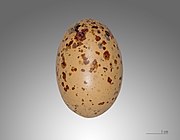 |
| Double-banded sandgrouse Pterocles bicinctus Temminck, 1815 |
 |
Length 31 to 39 centimetres (12 to 15 in) There are three subspecies:[17] P. b. ansorgei– south west Angola P. b. bicinctus– Namibia, Botswana, north west Cape Province P. b. multicolor– Zambia, Malawi, Mozambique and Transvaal Status: Least concern |
|
| Burchell's sandgrouse Pterocles burchelli Sclater, 1922 |
 |
Length 25 cm (10 in) Monotypic[18] Angola, Namibia, Botswana, Zambia, Zimbabwe, South Africa Status: Least concern |
|
| Crowned sandgrouse Pterocles coronatus Lichtenstein, 1823 |
 |
There are five subspecies:[19] P. c. atratus– Saudi Arabia, Iran, Afghanistan P. c. coronatus– Sahara, Morocco to Red Sea P. c. ladas– Pakistan P. c. saturatus– Oman P. c. vastitas– Sinai, Israel, Jordan Status: Least concern |
|
| Black-faced sandgrouse Pterocles decoratus Cabanis, 1868 |
 |
There are three subspecies:[20] P. d. decoratus– south east Kenya and east Tanzania P. d. ellenbecki– north east Uganda, north Kenya, Ethiopia, Somalia P. d. loveridgei– west Kenya, west Tanzania Status: Least concern |
|
| Chestnut-bellied sandgrouse Pterocles exustus Temminck, 1825 (Pictured on left) |
 |
There are six subspecies:[21] P. e. ellioti– Sudan, Eritrea, north Ethiopia, Somalia P. e. erlangeri– Saudi Arabia, Gulf States, Yemen P. e. exustus– Mauritania to Sudan P. e. floweri– Egypt (almost certainly extinct) P. e. hindustan– south east Iran, Pakistan, India P. e. olivascens– south Ethiopia, Kenya, north Tanzania Status: Least concern |
|
| Yellow-throated sandgrouse Pterocles gutturalis Smith, 1836 |
 |
There are two subspecies:[22] P. g. gutturalis– south Zambia, Zimbabwe, Botswana, South Africa P. g. saturatior– Ethiopia, Kenya, Tanzania, north Zambia Status: Least concern |
|
| Painted sandgrouse Pterocles indicus (Gmelin, 1789) |
 |
Monotypic[23] India Status: Least concern |
 |
| Lichtenstein's sandgrouse Pterocles lichtensteinii Temminck, 1825 |
 |
There are five subspecies:[24] P. l. targius– Sahara, Sahel, south Morocco to Chad P. l. lichtensteinii– Israel, Sinai, Egypt, Sudan, Ethiopia, Somalia P. l. sukensis– Sudan, Ethiopia, Kenya P. l. ingramsi– Yemen P. l. arabicus– Saudi Arabia, Iran, Afghanistan, Pakistan Status: Least concern |
|
| Namaqua sandgrouse Pterocles namaqua (Gmelin, 1789) |
 |
Length 31 to 39 centimetres (12 to 15 in) Monotypic[25] Angola, Namibia, Zimbabwe, Botswana, South Africa Status: Least concern |
|
| Black-bellied sandgrouse Pterocles orientalis (Linnaeus, 1758) |
 |
There are two subspecies:[26] P. o. arenarius– Kazakhstan, Pakistan and western China P. o. orientalis– Northwest Africa, Canary Islands, Iberian Peninsula, Cyprus, Middle East, Turkey and Iran Status: Least concern |
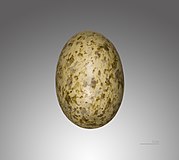 |
| Madagascar sandgrouse Pterocles personatus Gould, 1843 |
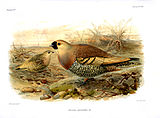 |
Monotypic[27] Madagascar Status: Least concern |
|
| Four-banded sandgrouse Pterocles quadricinctus (Temminck, 1815) |
 |
Length 25 to 28 centimetres (9.8 to 11.0 in) Monotypic[28] Central Africa Status: Least concern |
 |
| Spotted sandgrouse Pterocles senegallus (Linnaeus, 1771) |
 |
Length 33 centimetres (13 in) Monotypic[29] Northern Africa, Middle East and western Asia Status: Least concern |
 |
| Tibetan sandgrouse Syrrhaptes tibetanus (Gould, 1850) |
 |
Length 30 to 41 centimetres (12 to 16 in) Monotypic[30] Mountains of central Asia, Tibet and central China Status: Least concern |
|
| Pallas's sandgrouse Syrrhaptes paradoxus (Pallas, 1773) |
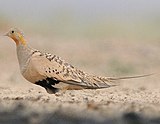 |
Length 30 to 41 centimetres (12 to 16 in) Monotypic[31] Mountains and steppes of central Asia Status: Least concern |
 |
Relations with humans
[edit]Sandgrouse have little interaction with people, primarily because most species live in arid unpopulated areas and at low densities. They are not generally sought after asgame birdsas they are not especially palatable, although they have on occasion been taken in great numbers at water holes. An attempt tointroducethem intoNevadafailed but they have been introduced toHawaii.[32]No species is considered to be threatened although there have been some localised range contractions, particularly in Europe.[33]A subspecies of the chestnut-bellied sandgrouse,P. e. floweri,was last seen in theNile Valleyof Egypt in 1979. It is thought to be extinct, but the reasons for this are unknown.[34]
References
[edit]- ^abcdeCampbell, Bruce; Lack, Elizabeth (1985).A Dictionary of Birds.Buteo Books. p. 520.ISBN0-931130-12-3.
- ^abCrome, France H.J. (1991). Forshaw, Joseph (ed.).Encyclopaedia of Animals: Birds.London: Merehurst Press. pp. 114–115.ISBN1-85391-186-0.
- ^abcdeGooders, John, ed. (1979).Birds of Heath and Woodland: Pteroclidae: Sandgrouse.London: Orbis Publishing Ltd. pp. 2–11.ISBN0-85613-380-9.
- ^abcd"Pteroclidae Sandgrouse".Creagrus: Bird Families of the World.Retrieved2012-05-30.
- ^"Pterocles namaqua(Namaqua sandgrouse) ".Biodiversity.Retrieved2012-06-06.
- ^Ward, P. (1972). "The functional significance of mass drinking flights by sandgrouse (Pteroclididae)".Ibis.114(4): 533–536.doi:10.1111/j.1474-919X.1972.tb00854.x.
- ^Ferns, P. N.; Hinsley, S. A. (1995). "Importance of Topography in the Selection of Drinking Sites by Sandgrouse".Functional Ecology.9(3): 371–375.doi:10.2307/2389999.JSTOR2389999.
- ^abHackett, Shannon J.; Kimball, Rebecca T.; Reddy, Sushma; et al. (2008). "A phylogenomic study of birds reveals their evolutionary history".Science.320(5884): 1763–1768.Bibcode:2008Sci...320.1763H.doi:10.1126/science.1157704.PMID18583609.S2CID6472805.
- ^Maclean, G. L. (1967). "Die systematische Stellung der Flughühner(Pteroclididae)".Journal of Ornithology.108(2): 203–217.doi:10.1007/BF01671410.S2CID39713128.
- ^Lorenz, K. (1939). "Verhandl".Deutsch. Zool. Ges.(in German).41(Zool. Anz. Suppl. 12): 69–102.
- ^Cade, T. J.; Willoughby, E. J.; Maclean, G. L. (1966)."Drinking behavior of sandgrouse in the Namib and Kalahari deserts, Africa"(PDF).The Auk.83(1).
- ^Crome, F.H.J.; Hutchins, M.; Thoney, D.A.; McDade, M.C., eds. (2004).Birds II: Columbiformes (Pigeons, Doves, and Dodos).Vol. 9 (2nd ed.). Detroit, MI: Gale. pp. 241–246.
- ^Fain, Matthew G.; Houde, Peter (2004). "Parallel radiations in the primary clades of birds".Evolution.58(11): 2558–2573.doi:10.1554/04-235.PMID15612298.S2CID1296408.
- ^Boyd, John (2007)."METAVES I Columbimorphae, Eurypygimorphae"(PDF)(personal website).Retrieved30 December2015.
- ^del Hoyo, J.; Elliot, A.; Sargatal, J., eds. (1997).Handbook of the Birds of the World Volume 4: Sandgrouse to Cuckoos.Lynx Editions.ISBN84-87334-22-9.
- ^"Pin-tailed sandgrouse(Pterocles alchata)".The Internet Bird Collection.Retrieved2012-06-02.
- ^"Double-banded sandgrouse(Pterocles bicinctus)".The Internet Bird Collection.Retrieved2012-06-02.
- ^"Burchell's sandgrouse(Pterocles burchelli)".The Internet Bird Collection.Retrieved2012-06-02.
- ^"Crowned sandgrouse(Pterocles coronatus)".The Internet Bird Collection.Retrieved2012-06-02.
- ^"Black-faced sandgrouse(Pterocles decoratus)".The Internet Bird Collection.Retrieved2012-06-02.
- ^"Chestnut-bellied sandgrouse(Pterocles exustus)".The Internet Bird Collection.Retrieved2012-06-02.
- ^"Yellow-throated sandgrouse(Pterocles gutturalis)".The Internet Bird Collection.Retrieved2012-06-02.
- ^"Painted sandgrouse(Pterocles indicus)".The Internet Bird Collection.Retrieved2012-06-02.
- ^"Lichtenstein's sandgrouse(Pterocles lichtensteinii)".The Internet Bird Collection.Retrieved2012-06-02.
- ^"Namaqua sandgrouse(Pterocles namaqua)".The Internet Bird Collection.Retrieved2012-06-02.
- ^"Black-bellied sandgrouse(Pterocles orientalis)".The Internet Bird Collection.Retrieved2012-06-02.
- ^"Madagascan sandgrouse(Pterocles personatus)".The Internet Bird Collection.Retrieved2012-06-02.
- ^"Four-banded sandgrouse(Pterocles quadricinctus)".The Internet Bird Collection.Retrieved2012-06-02.
- ^"Spotted sandgrouse(Pterocles senegallus)".The Internet Bird Collection.Retrieved2012-06-02.
- ^"Tibetan sandgrouse(Syrrhaptes tibetanus)".The Internet Bird Collection.Retrieved2012-06-02.
- ^"Pallas's sandgrouse(Syrrhaptes paradoxus)".The Internet Bird Collection.Retrieved2012-06-02.
- ^"Chestnut Bellied Sandgrouse".Ultimate Upland. Archived fromthe originalon 2012-11-04.Retrieved2012-06-29.
- ^"IUCN Red List of Threatened Species".2012.1.IUCN.Retrieved2012-06-29.
- ^Hume, J. P.; Walters, M. (2012).Extinct Birds.London: A & C Black. p. 133.ISBN978-1-4081-5725-1.
External links
[edit]- Sandgrouse videoson the Internet Bird Collection
- .New International Encyclopedia.1905.
